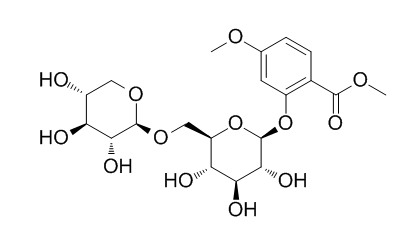Primverin
Reference standards.
Inquire / Order:
manager@chemfaces.com
Technical Inquiries:
service@chemfaces.com
Tel:
+86-27-84237783
Fax:
+86-27-84254680
Address:
1 Building, No. 83, CheCheng Rd., Wuhan Economic and Technological Development Zone, Wuhan, Hubei 430056, PRC
Providing storage is as stated on the product vial and the vial is kept tightly sealed, the product can be stored for up to
24 months(2-8C).
Wherever possible, you should prepare and use solutions on the same day. However, if you need to make up stock solutions in advance, we recommend that you store the solution as aliquots in tightly sealed vials at -20C. Generally, these will be useable for up to two weeks. Before use, and prior to opening the vial we recommend that you allow your product to equilibrate to room temperature for at least 1 hour.
Need more advice on solubility, usage and handling? Please email to: service@chemfaces.com
The packaging of the product may have turned upside down during transportation, resulting in the natural compounds adhering to the neck or cap of the vial. take the vial out of its packaging and gently shake to let the compounds fall to the bottom of the vial. for liquid products, centrifuge at 200-500 RPM to gather the liquid at the bottom of the vial. try to avoid loss or contamination during handling.
Toxicol In Vitro.2024, 99:105876.
J Health Sci Med Res.2023, 31584.
Drug Des Devel Ther.2023, 17:2461-2479.
Int J Mol Sci.2017, 18(12)
Foods.2022, 11(6):882.
J. of The Korean Society of Food Culture2017, 144-149
Cell Rep.2022, 39(1):110643.
The Journal of Animal & Plant Sciences.2020, 30(6):1366-1373
Anticancer Res.2018, 38(4):2127-2135
Pharmaceutics.2022, 14(5):945.
Related and Featured Products
International Journal of Analytical Chemistry, 2017, 2017(1):1-7.
Phenolics in Primula veris L. and P. elatior (L.) Hill Raw Materials.[Reference:
WebLink]
Primula veris L. and Primula elatior (L.) Hill represent medicinal plants used for the production of herbal teas and preparations with antioxidant and expectorant activity. Flowers and roots of both species possess the same biological activity.
METHODS AND RESULTS:
In the presented study, raw materials of wild growing P. veris and P. elatior were compared in terms of the content and composition of phenolic compounds using a fast and simple HPLC-DAD method. The study showed that flowers of both species were rich in flavonoids. However, P. veris flowers were characterized with a distinctly higher content of isorhamnetin-3-O-glucoside, astragalin, and (+)-catechin, whereas P. elatior occurred to be a richer source of rutoside and isorhamnetin-3-O-rutinoside. Hyperoside was found exclusively in P. elatior flowers. Phenolic glycosides (Primverin and primulaverin) were identified only in the roots. Their content was about ten times higher in P. veris in comparison with P. elatior underground organs.
CONCLUSIONS:
The obtained results clearly show that both Primula species differ distinctly in terms of the content and composition of phenolic compounds. The compounds differentiating both species to the highest degree (hyperoside, in flowers, as well as Primverin and primulaverin, in the roots) may be useful chemical markers in the identification and evaluation of both species.



